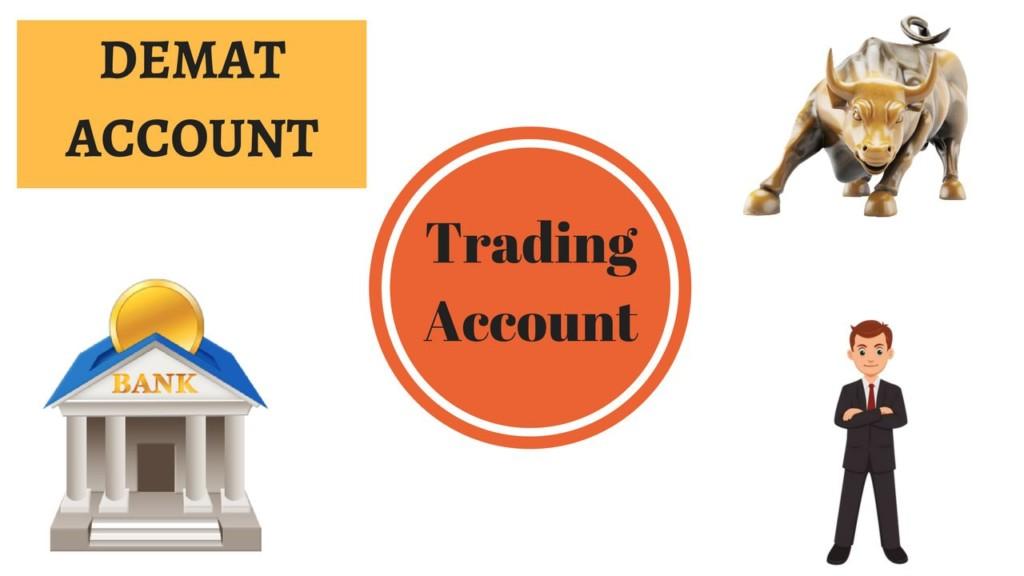When you buy and sell stocks there is trading account and Demat account that are involved. Many investors tend to use the terms Trading account and Demat account interchangeably. While they are closely related, they are not one and the same. The trading account and the demat account have an important role to play in your investment process. Let us see how the demat account and the trading account interface?
If you buy or sell equities then you need a trading account and a demat account. The confusion is more because you tend to open a trading account and a demat account simultaneously with your broker (also known as trading-cum-demat account). Brokers refer to this as a 2-in-1 account where the trading account and the demat account are opened simultaneously. While both the trading account and the demat account are part of your overall trading process, their roles and their purpose is quite different. In the process, you must also be familiar with the third facet of your investing account which is your banking account.
What is the role played by your trading account?
A trading account is a flow book that records the flow of transactions. That means all your transactions in equity, futures and options are executed in the trading account only. Whether you are buying shares or selling shares, it has to be done through your trading account opened with the broker. In the trading account, when you place an order to buy or sell, it first gets reflected in the order book. You can either trade online using the internet or the app or you can even trade offline by calling up your broker. You can either place a limit order or a market order depending on your view on the stock. Normally, market orders will get executed immediately but limit orders are executed only when the price condition is met. Remember, that an order placed in the trading account can be cancelled as long as it remains in the order book. Once the order is executed, then the order moves into the trade book. An order book shows executed and unexecuted orders whereas the trade account only shows the executed orders. The trade book is the record of all your transactions executed during the day. The trading account can be used to buy or sell equities, F&O, bonds and ETFs. In case you only want to trade in futures & options (F&O), then you do not require a demat account and only trading account will suffice. Your participation in the equity markets has to begin with a trading account.
Then, what role does your demat account play?
While the trading account is a flow book, the Demat Account is a stock book. Demat account is a statement of ownership. Therefore only securities that you can own will go into your demat account. It records all the shares and other securities that you own. While Trading Account is reviewed over a period of time, the Demat Account is normally reviewed at a point of time since it is all about holdings. Since Demat account is a statement of ownership, any sale of shares will be debited to the demat account and any purchase of shares will be credited to the demat account. This is normally done through the T+2 process of rolling settlements. Demat account also directly receives the effect of corporate actions like dividends, stock splits and bonus issues.
There are two ways to look at the classification of corporate actions and their impact on demat account. Corporate actions in the demat account can be cash or non-cash. In non-cash corporate actions like bonus and splits, the demat account will automatically give effect to the change in your holdings. In case of cash corporate actions like interest and dividends, the DP will only upload holders’ data and the payment is directly made by the Registrar & Transfer Agent (RTA) into the registered bank account. Another way to look at corporate actions in your demat account is voluntary versus involuntary. Corporate actions like dividends, bonus and splits are involuntary and will come automatically to you. Then there are voluntary corporate benefits like buybacks and rights where you have to exercise an option and only based on that the effect will be given in your demat account or to your bank account.
Understanding the intricate interplay between trading account and demat account
Trading account and demat account constitute 2 pillars of your investing. When you buy shares and the trade is confirmed, these shares get credited to your demat account on the T+2 day. T+2 refer to 2 trading days after the date of transaction (excluding trading holidays). When you sell shares in your trading account, the shares get debited to your demat account on T+1 day whereas your bank account gets credited on T+2 day. In an online trading account, the execution of trade and the debt/credit to demat is seamless. In offline trading, when you sell shares, you need to sign a Debit Instruction Slip (DIS) and hand over to your broker on the same day. Alternatively, you can give a power of attorney to your broker to debit your demat account appropriately.
Is it possible to have only Demat or only trading account without the other?
Technically, it is possible. For example, if you want to subscribe to an IPO or if you want to receive shares by way of transfer or transmission, then you only need a demat account. However, if you want to sell these shares then you will require a trading account. Can you have a trading account without demat account? Yes, if you only want to trade in futures and options then you do not need to have a demat account. However, if you want to trade equities (even if only intraday) you will require demat account as per SEBI regulations.













No Comments